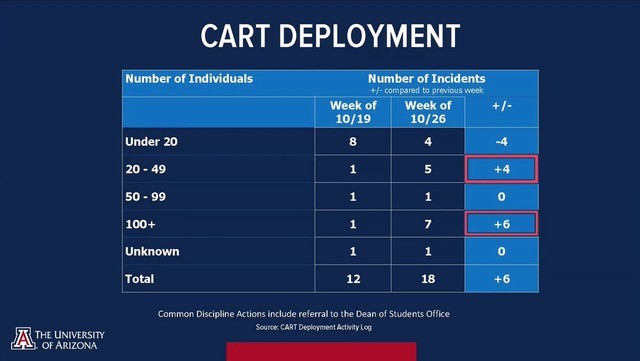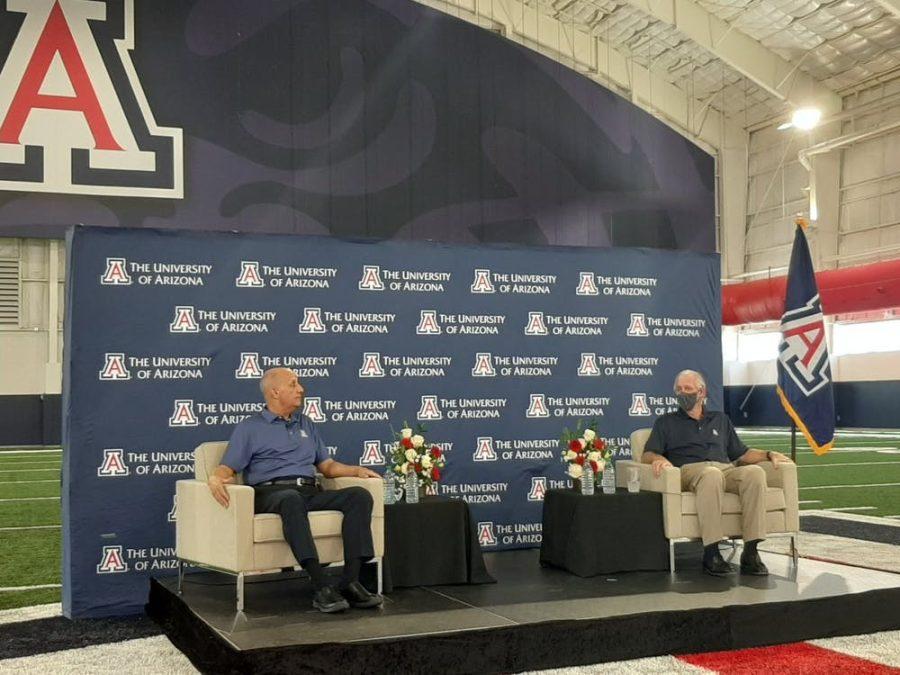Since its inception, the University of Arizona’s reentry task force attempted to lighten the massive load of uncertainty brought on by the COVID-19 pandemic by keeping members of the university community informed with data analysis, changes to university procedures, developments in new testing and treatments and more.
The Daily Wildcat took a look back at some of the highlights of the university’s status updates.
May 20, 2020 – The task force is born.
UA President Dr. Robert C. Robbins announced the creation of the reentry task force.
The task force would serve as the UA’s “incident command system” and would be led by Dr. Richard Carmona, the 17th surgeon general of the United States.
“We’re not going to open unless it’s safe,” Carmona said.
Carmona said the team would meet for a press conference on a weekly basis to keep the community informed “every step of the way.”
May 28, 2020 – Robbins goes on Meet the Press after discussing the possibility of reopening campus for in-person classes during the fall 2020 semester.
“We want to give our students that opportunity to choose,” Robbins said on the NBC program, “and we want to provide the maximum protections and safeguards to give [students], their loved ones, their parents the confidence that we can take care of them in a responsible way.”
June 11, 2020 – Faculty begin pushback against furlough plan.
During the reentry press conference, Robbins addressed concerns with a proposed furlough plan to dampen the impact of the university’s projected financial losses.
“We’re trying to preserve jobs,” Robbins said. “Our goal with this was to try to keep as many jobs as we possibly can.”
Afterwards, the Coalition for Academic Justice at UArizona held a press conference criticizing the plan for being unnecessary.
June 25, 2020 – ICU beds near capacity following surge in cases.
The task force walked back its commitment to reopening following a surge in COVID-19 infections and ICU beds nearing capacity.
“We’re nearing crisis levels of hospital utilization,” Robbins said. “The number of cases is one thing, but the number of cases of individuals getting sick enough to have to go into the hospital and then utilize and ICU bed is something that I think is very, very important and we should keep our eye on, which we are doing.”
Robbins also noted during the conference that he would keep an eye on the results of a faculty vote to delay the proposed furlough plan.
June 30, 2020 – Robbins delays furloughs.
Robbins announced that he would officially delay the implementation of the university’s furlough plan following a vote by the general faculty.
Of the 1,462 people who voted, 1,305 voted in favor of recommending to delay furloughs, 128 voted against the recommendation and 29 abstained.
RELATED: Food insecurity among UA students doubled during the pandemic
July 23, 2020 – The UA officially announces fall reopening.
Robbins announced that the university will reopen campus to hold some in-person classes and to accommodate on-campus residents.
“I know many of you are awaiting the answer to the question: ‘Will the University of Arizona be open for in-person classes in the fall of 2020?’ The answer is yes,” Robbins said.
July 30, 2020 – The task force proposes its initial reentry plan.
During its press conference on July 30, the task force put forward a three-week plan for reopening campus that planned to have all students physically back in class by the third week of the semester.
They also announced the testing requirement for move-in and the 10-day isolation protocol for students who test positive.
Aug. 4, 2020 – Unionization and acquisition.
On the same day that CAJUA declared its intention to unionize UA faculty, the university announced it has acquired Ashford University, which will become “UA Global Campus.”
Ashford University was a for-profit, all-online university that faced scrutiny allegations of fraud, which it paid over $7 million to settle while also denying wrongdoing.
Aug. 6, 2020 – The task force revises its reentry plan.
A week after putting forward a three-week reentry plan, Robbins announced revisions to the plan which expand the length of each phase to two and three weeks, “based on counsel from the UA College of Public Health.”
CAJUA had criticized the plan in a Faculty Senate meeting Aug. 4, saying that senior administration members “failed to justify their calendar-based re-entry plan” and that faculty from the College of Public Health said the three-week reentry period was “not sufficient time to evaluate how and if the plan is working.”
Aug. 28, 2020 – A vindication of wastewater epidemiology.
Following the first week of the fall semester, a potential COVID-19 outbreak in the Likins dorm was avoided thanks to early detection of the virus through wastewater testing. After testing all residents in the building, two cases of COVID-19 were identified, and the residents were isolated until they recovered.
Sept. 14, 2020 – Students ordered to shelter-in-place following spike in cases.
The task force briefed the viewers on a shelter-in-place directive for students living on and near campus. The order came in response to an increase in the rate of coronavirus transmission within the last week
Oct. 19, 2020 – The UA breaks up with spring break.
Provost Liesl Folks joined the task force to announce that the 2021 spring break will be broken up into five reading days spread throughout the spring semester.
The unpopular decision was made “to minimize the impact of student travel on community spread of COVID-19,” Robbins said.
Nov. 2, 2020 – Spooks and ghouls disregard public health to celebrate Halloween.
The week of Halloween, the University Campus Area Response Team was deployed to the most incidents of large gatherings to date. Seven of the 18 incidents recorded were gatherings of over 100 students.

Nov. 23, 2020 – Case count reaches record high in Pima County.
Dr. Theresa Cullen, director of the Pima County Health Department, informed the task force of the massive increase in COVID-19 transmission in the county.
“Yesterday we reported the highest number of cases we have ever reported in Pima County,” Cullen said during the conference. “On Friday, we had the highest particulate of SARS Cov2 virus in the wastewater in the Tucson area that we have recorded since we started recording which is March.”
Jan. 19, 2021 – The UA begins vaccinating Pima educators.
The university began vaccination of all 15,000 UA staff and faculty on Jan. 16, as well as all nearby childcare providers, K-12 educators and staff and all Pima Community College faculty and staff.
Feb. 15 – The UA becomes state Point of Distribution.
The task force announced that the university will become a state vaccine POD, giving it the resources needed to run 24/7 and to vaccinate state residents in the broader southern Arizona community.
Feb. 22 – Community mourns the loss of Forrest Keys.
The task force acknowledged and lamented the tragic death of Forrest Keys the previous weekend.
Keys, a sophomore majoring in communication and member of the Zeta Beta Tau fraternity, was killed the night of Feb. 20 in a shooting that occurred in the Cherry Avenue garage.
March 8 – May commencement plans announced.
Robbins announced to the press that the UA plans to hold commencement ceremonies for the 2021 graduating class.
“Provost Folks and I are very pleased to announce that the University of Arizona will celebrate the class of 2021 with a series of in-person ceremonies tentatively scheduled from Tuesday, May 11, to Tuesday, May 18,” Robbins said.
March 29 – UA POD surpasses milestone of 100,000 vaccinations.
After just over two months of administering COVID-19 vaccines and opening up appointments to all students, the university surpassed a total number of 100,000 doses administered.
Robbins said his goal is to vaccinate all students who want a vaccine before the end of the spring semester.
May 3 – UA announces plans to aid underserved communities
The university planed to reach out to rural and underserved communities to distribute vaccines as local and state PODs become decommissioned.
“To date, the University of Arizona mobile health clinic, which Dr. Carmona has mentioned in previous briefings, has dispensed well over 10,000 doses of vaccine across the state,” Robbins said. “We want to build on this effort and members of our team have been collaborating with the Santa Cruz County health department and the Mexican Consulate of Nogales to hold a clinic.”
The team will hold conferences during the summer as necessary and will resume weekly updates when the fall 2021 semester begins.
Follow Kristijan Barnjak on Twitter








